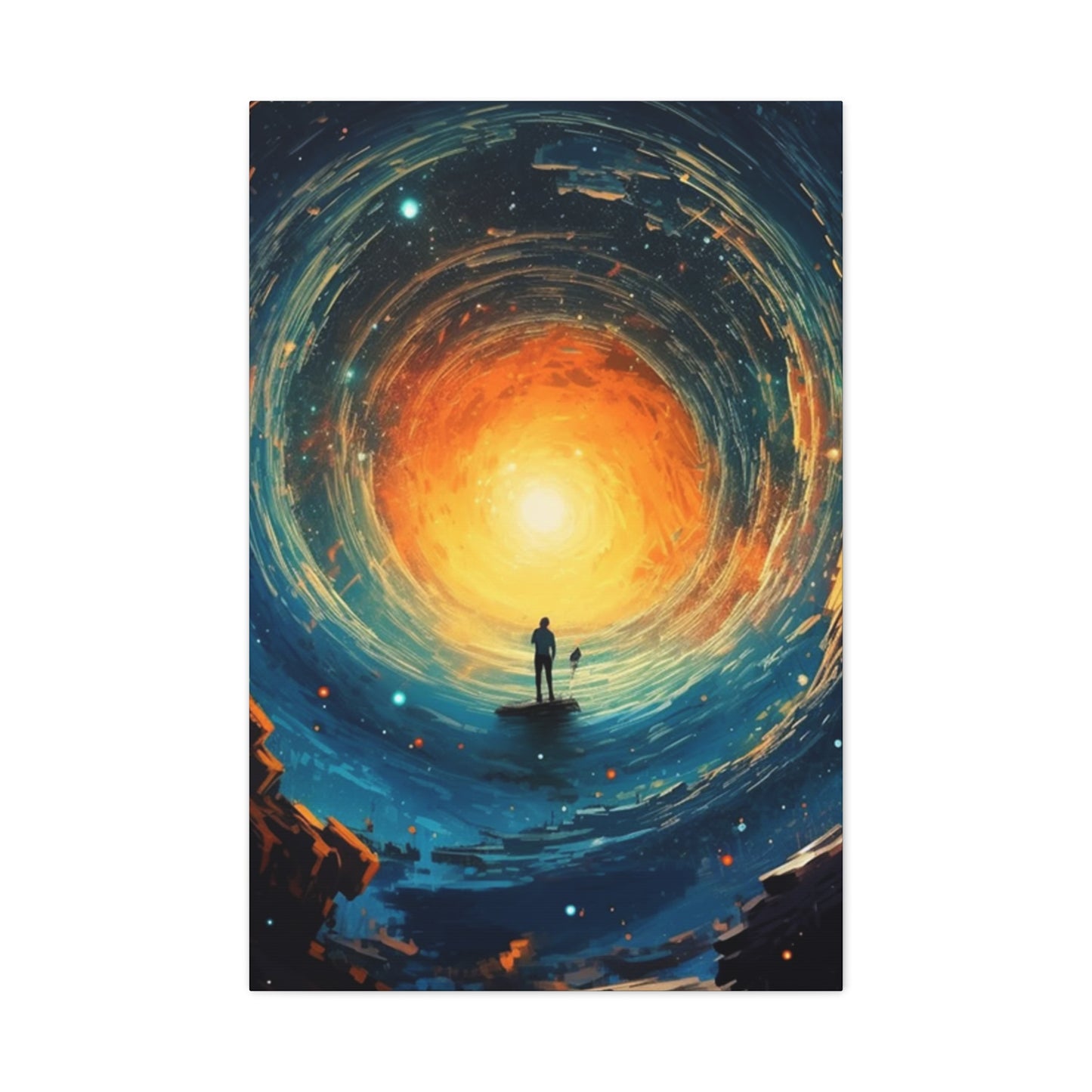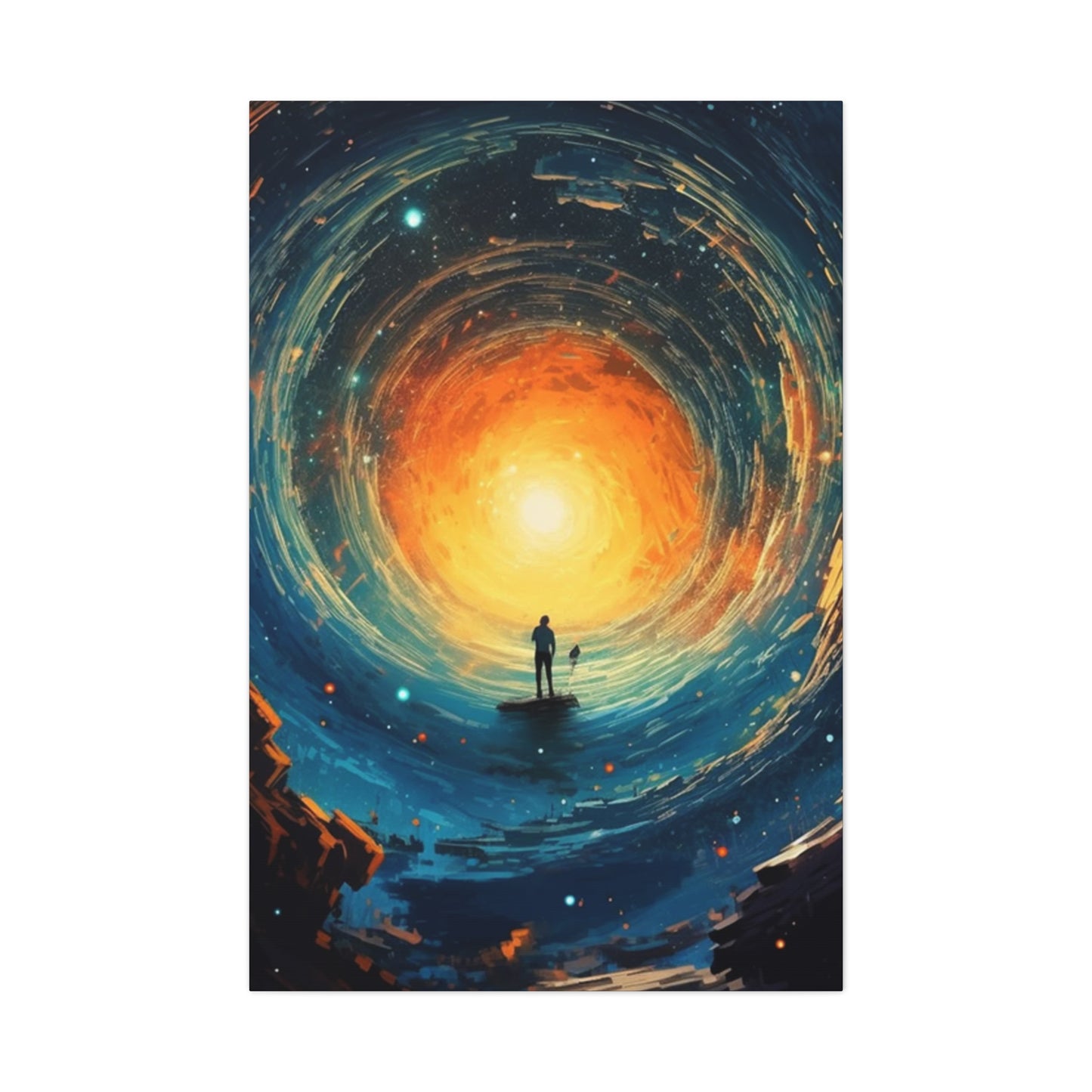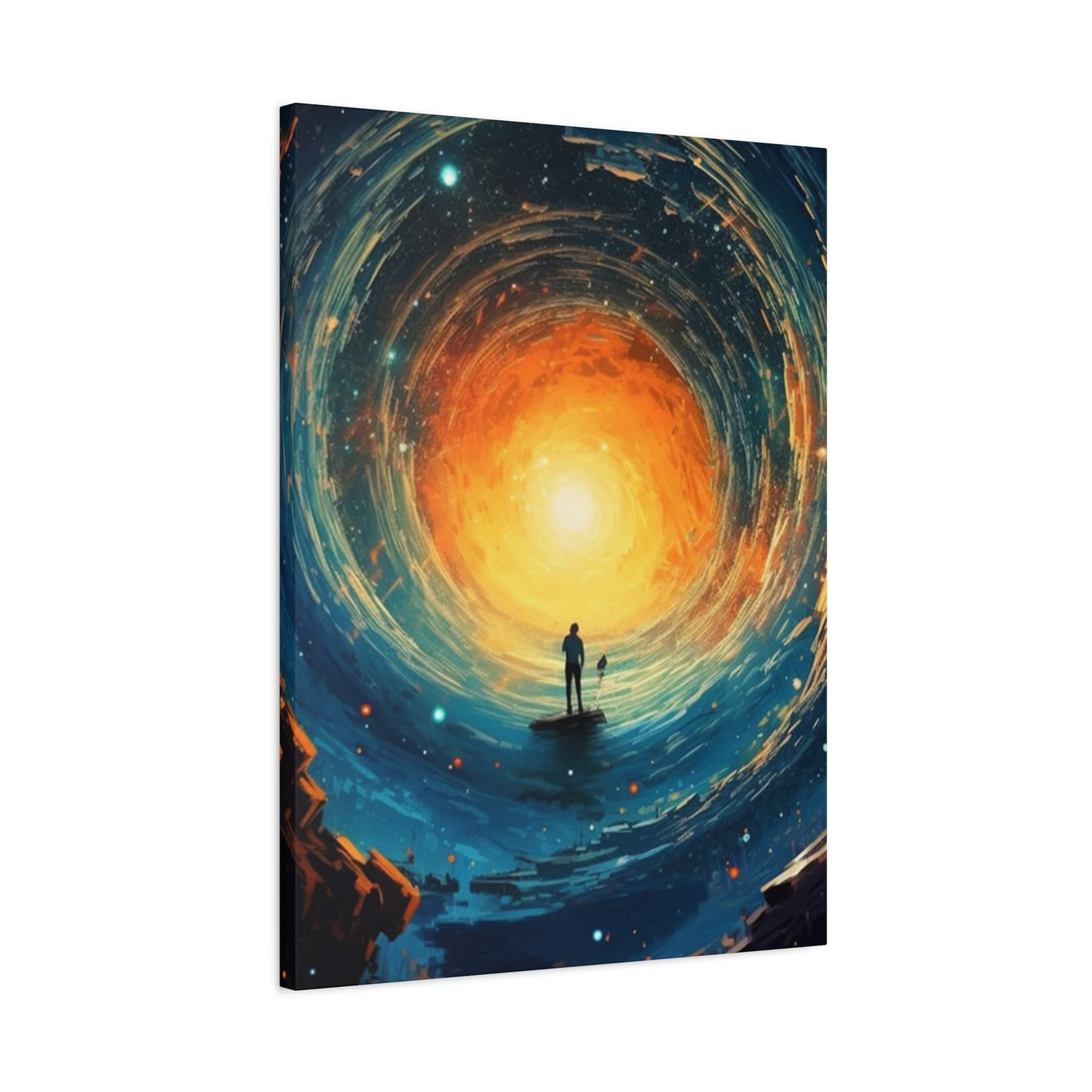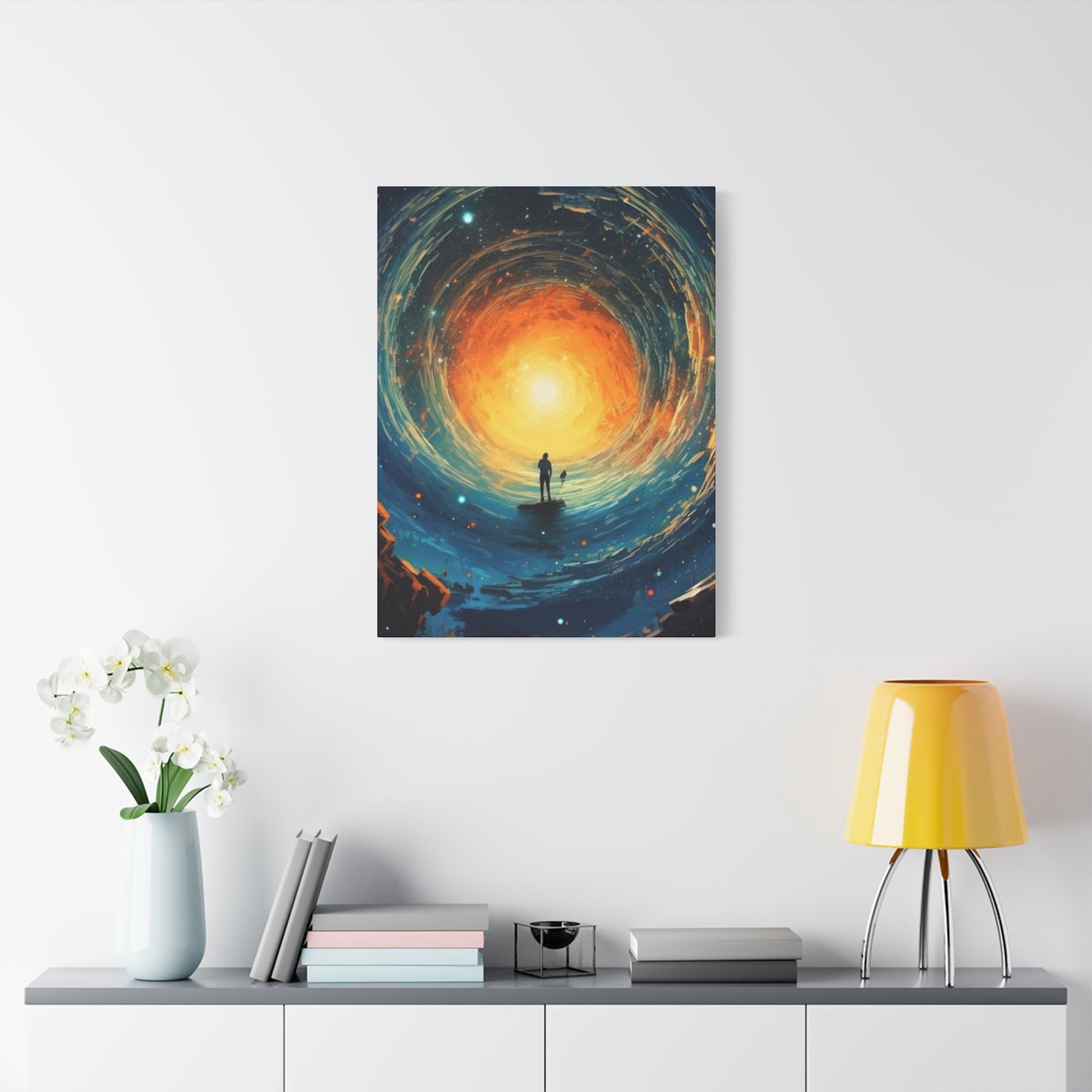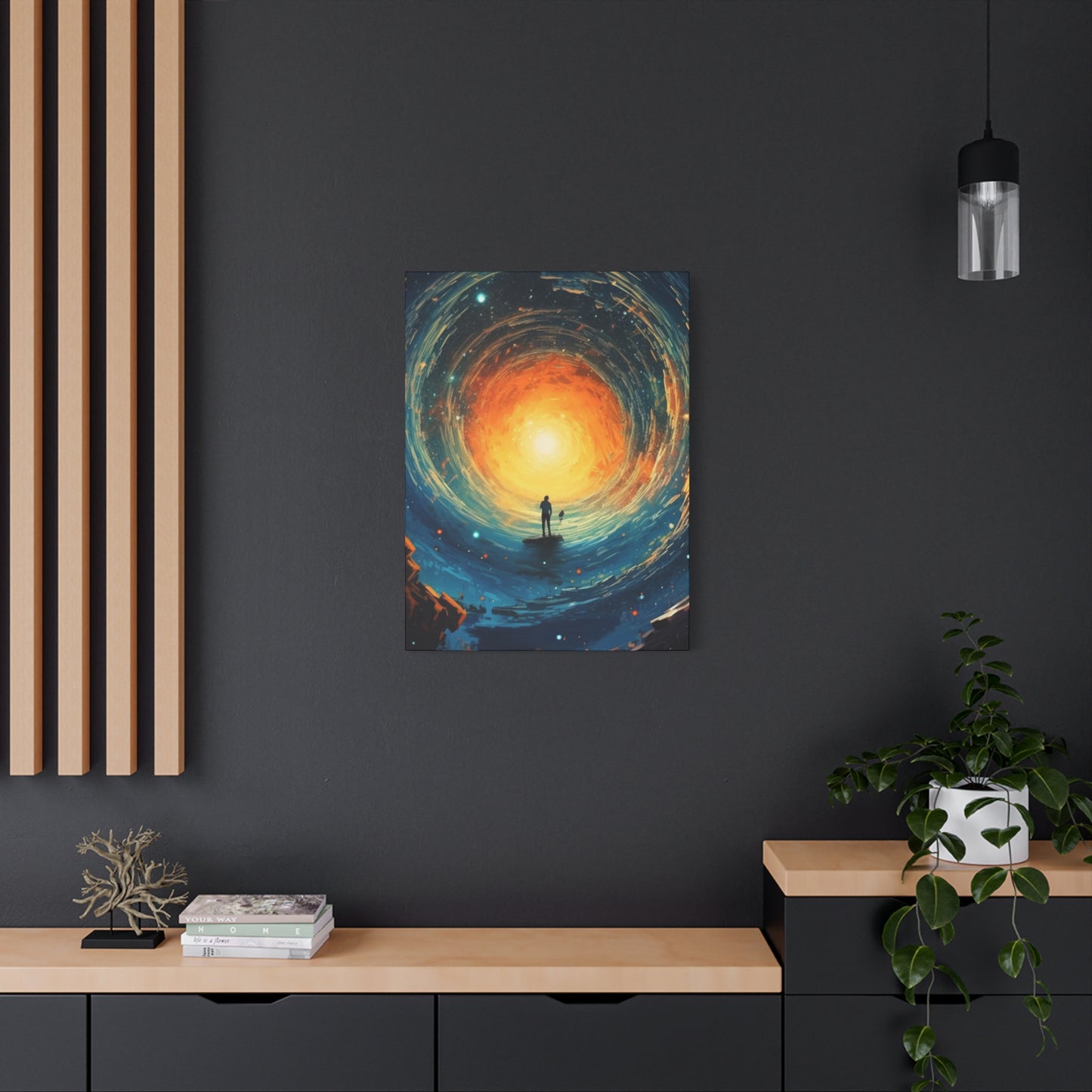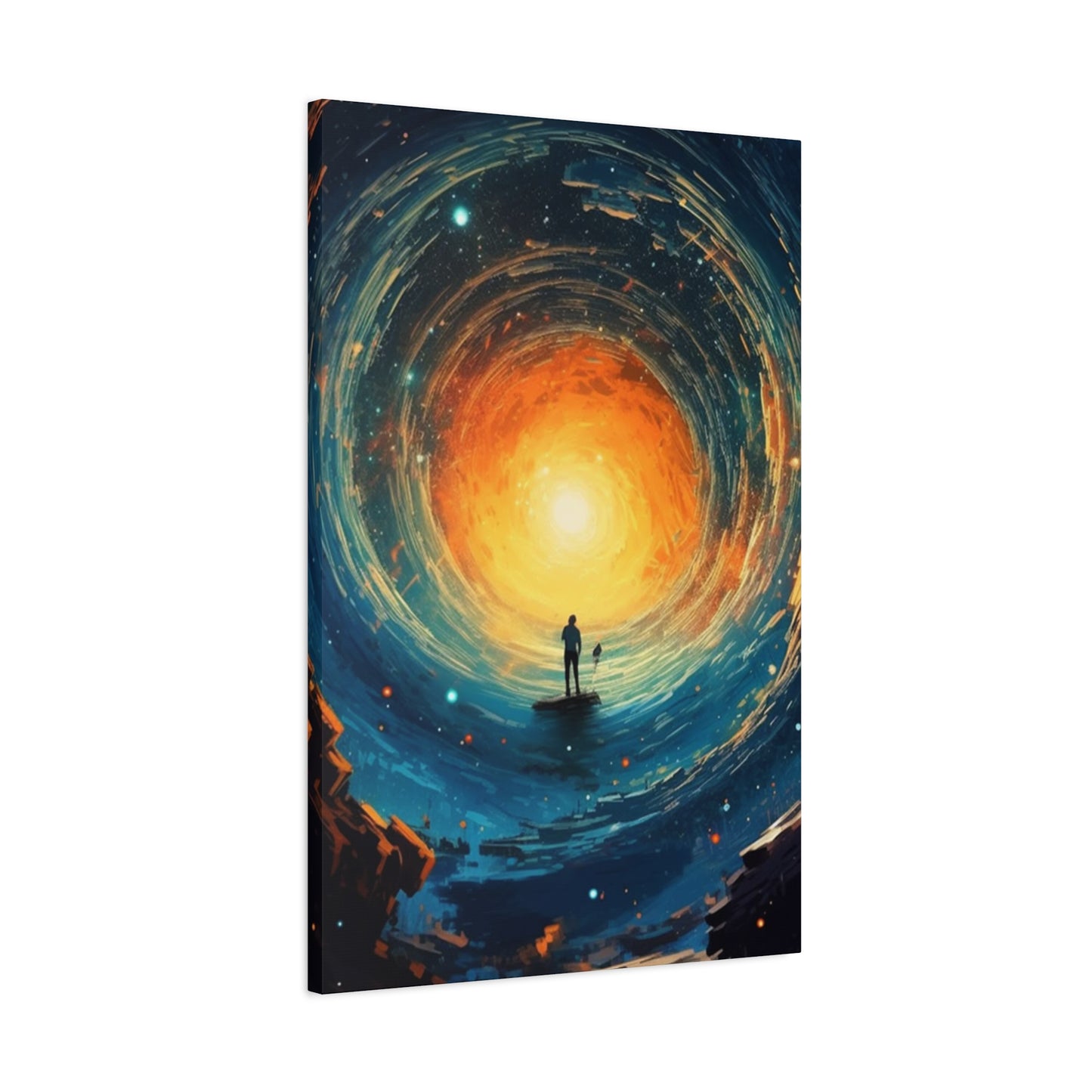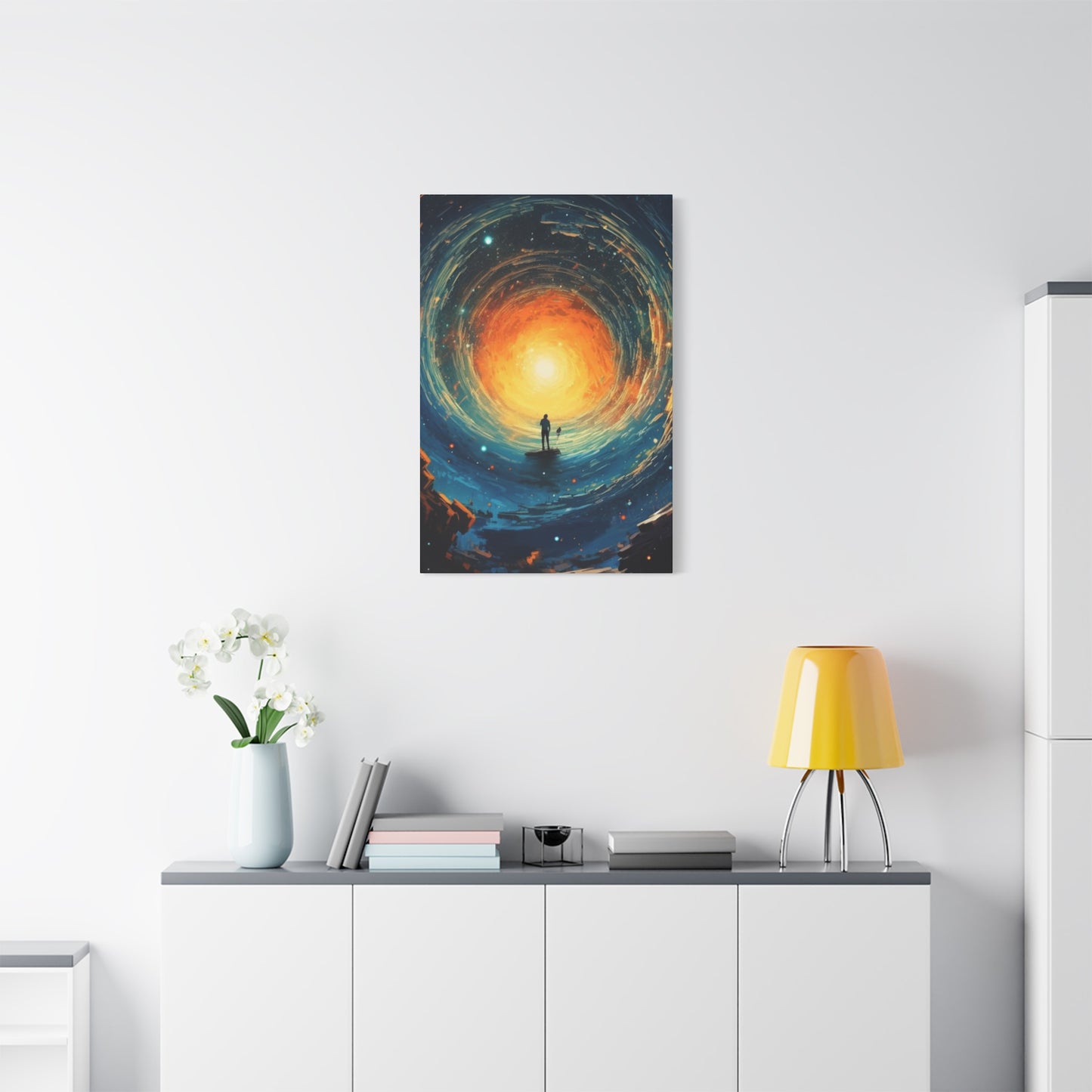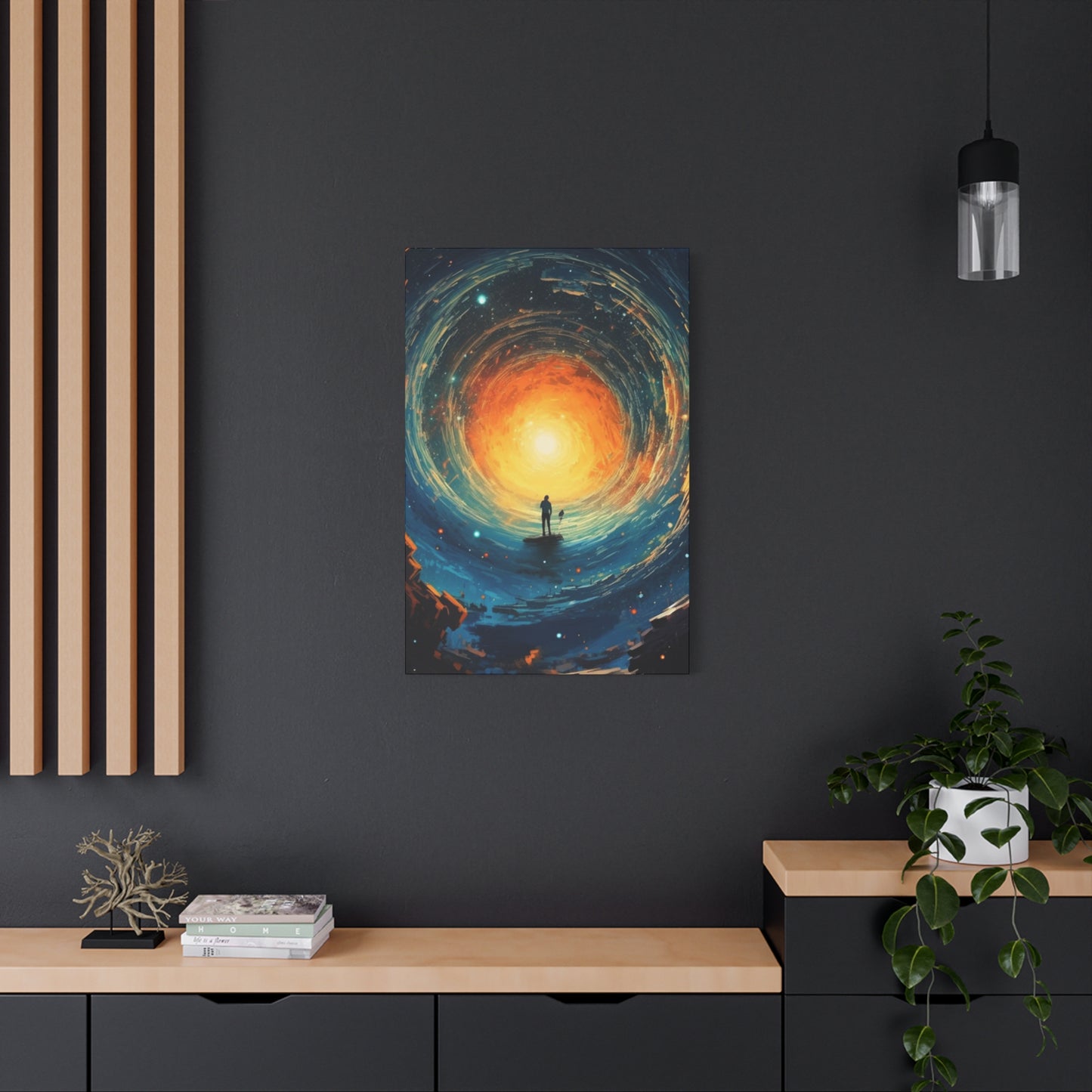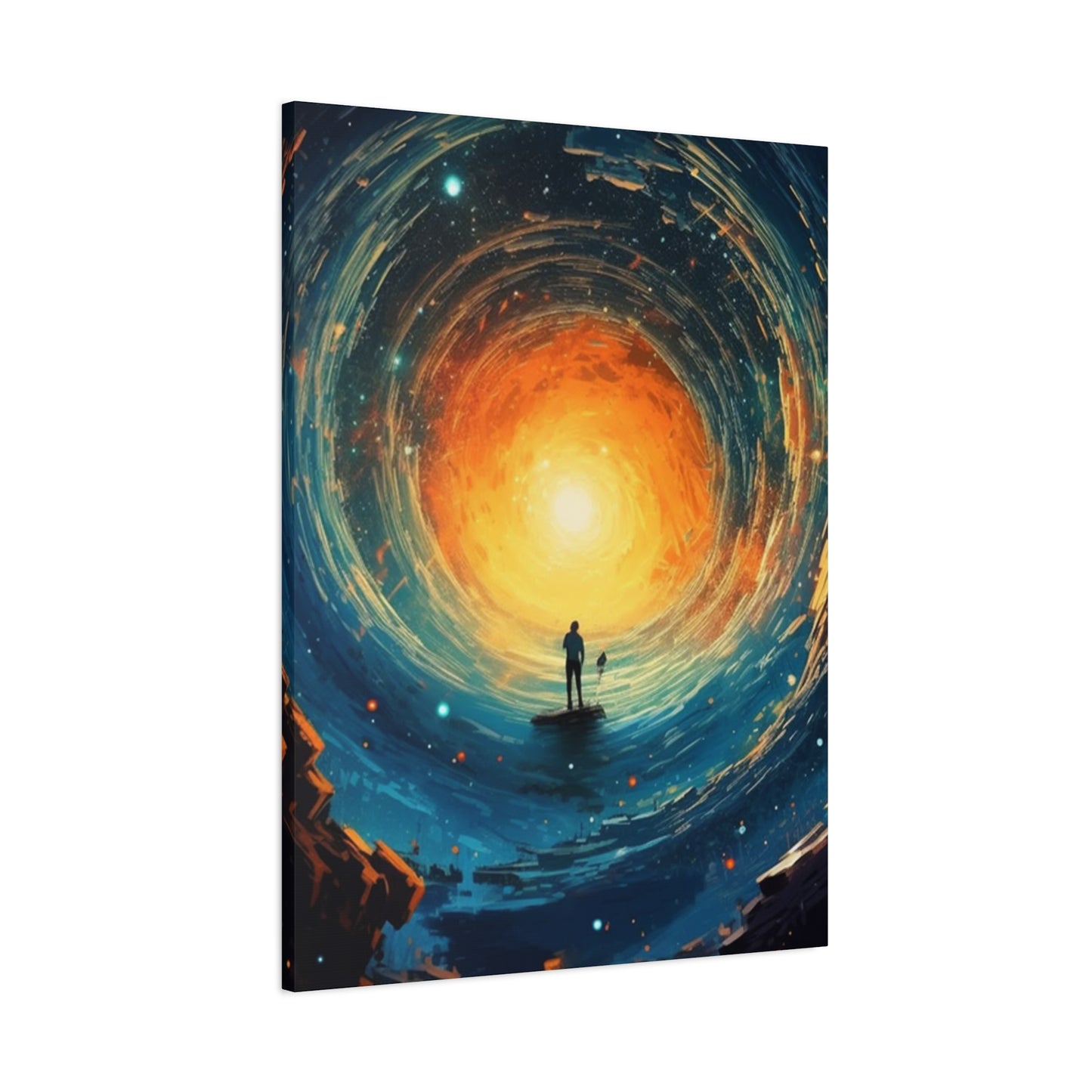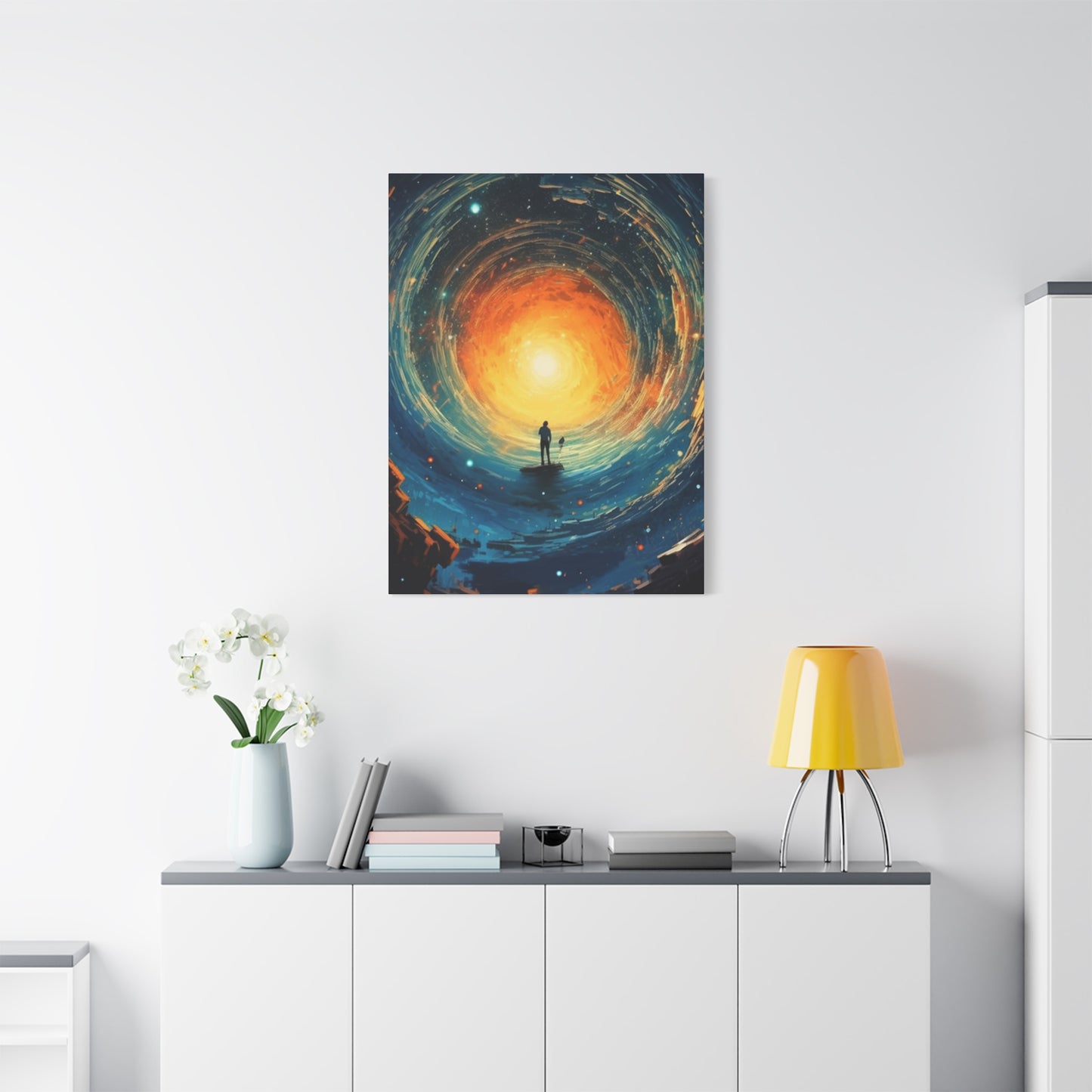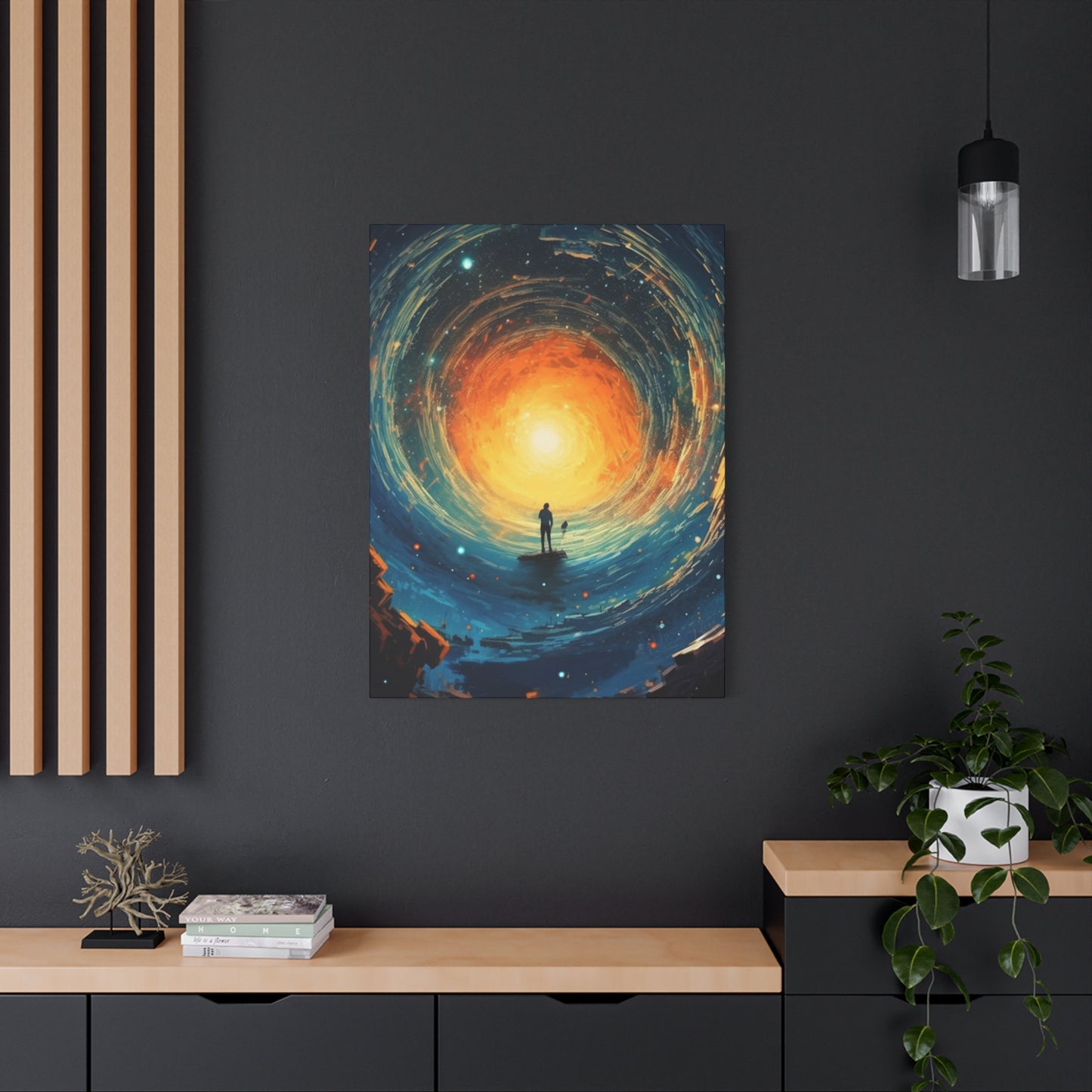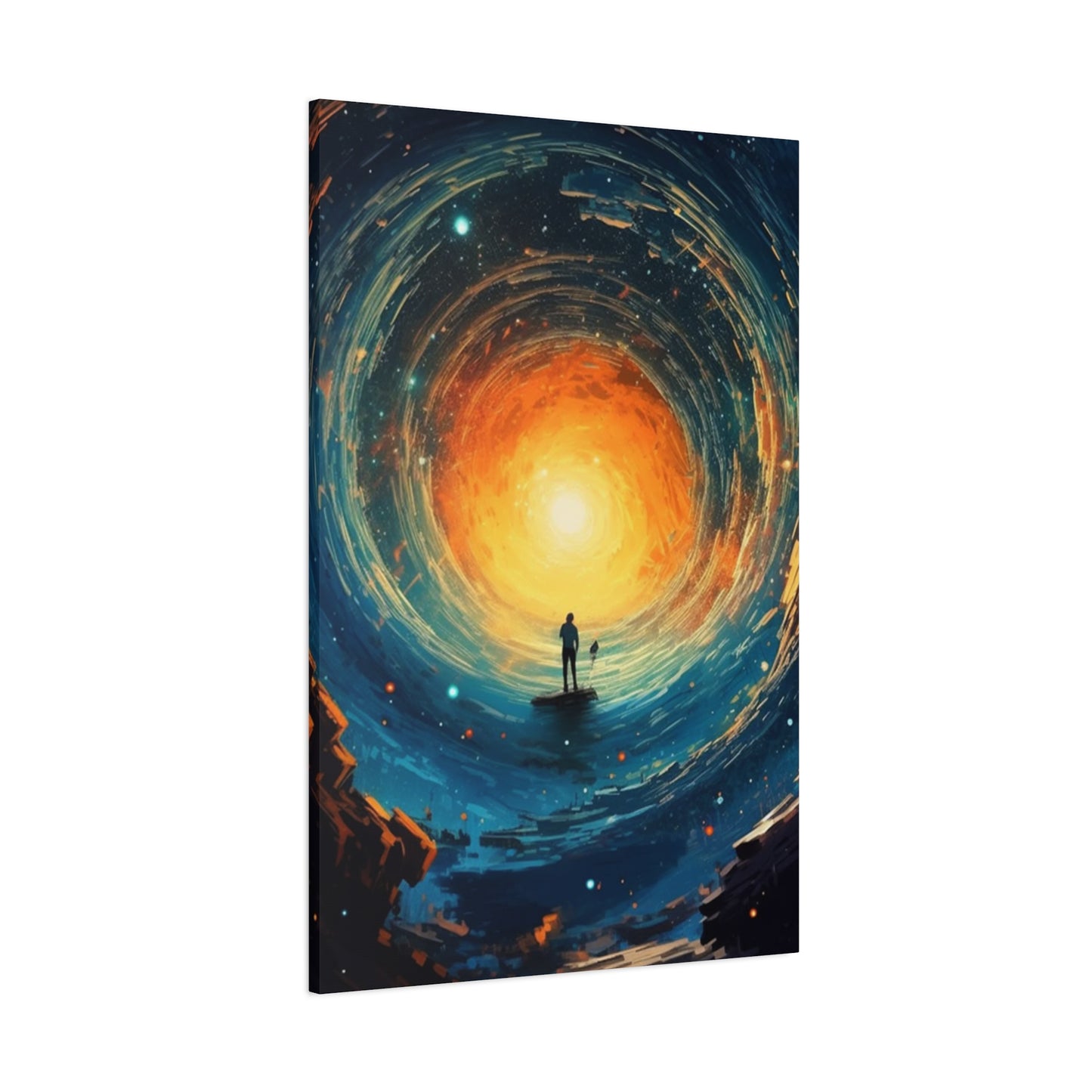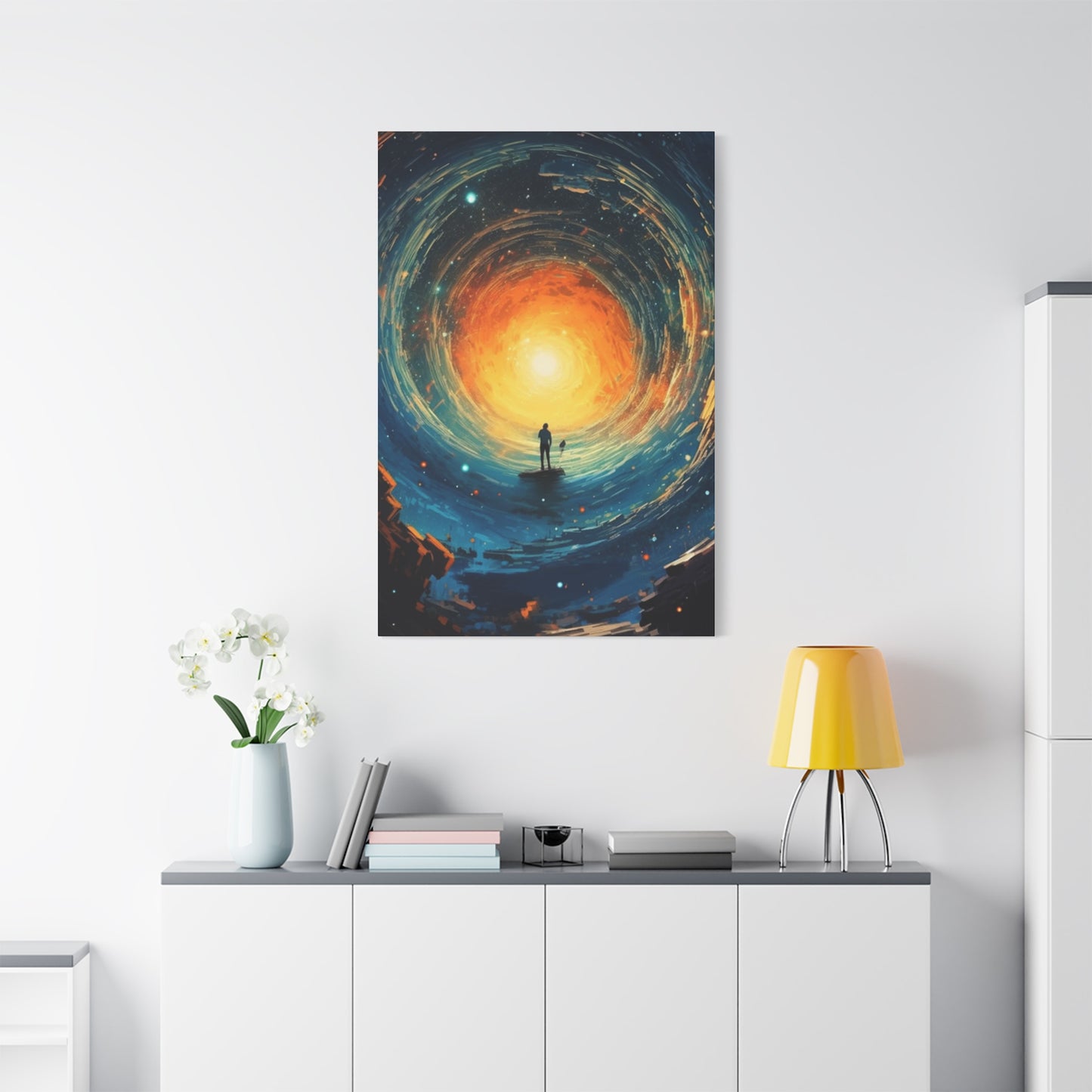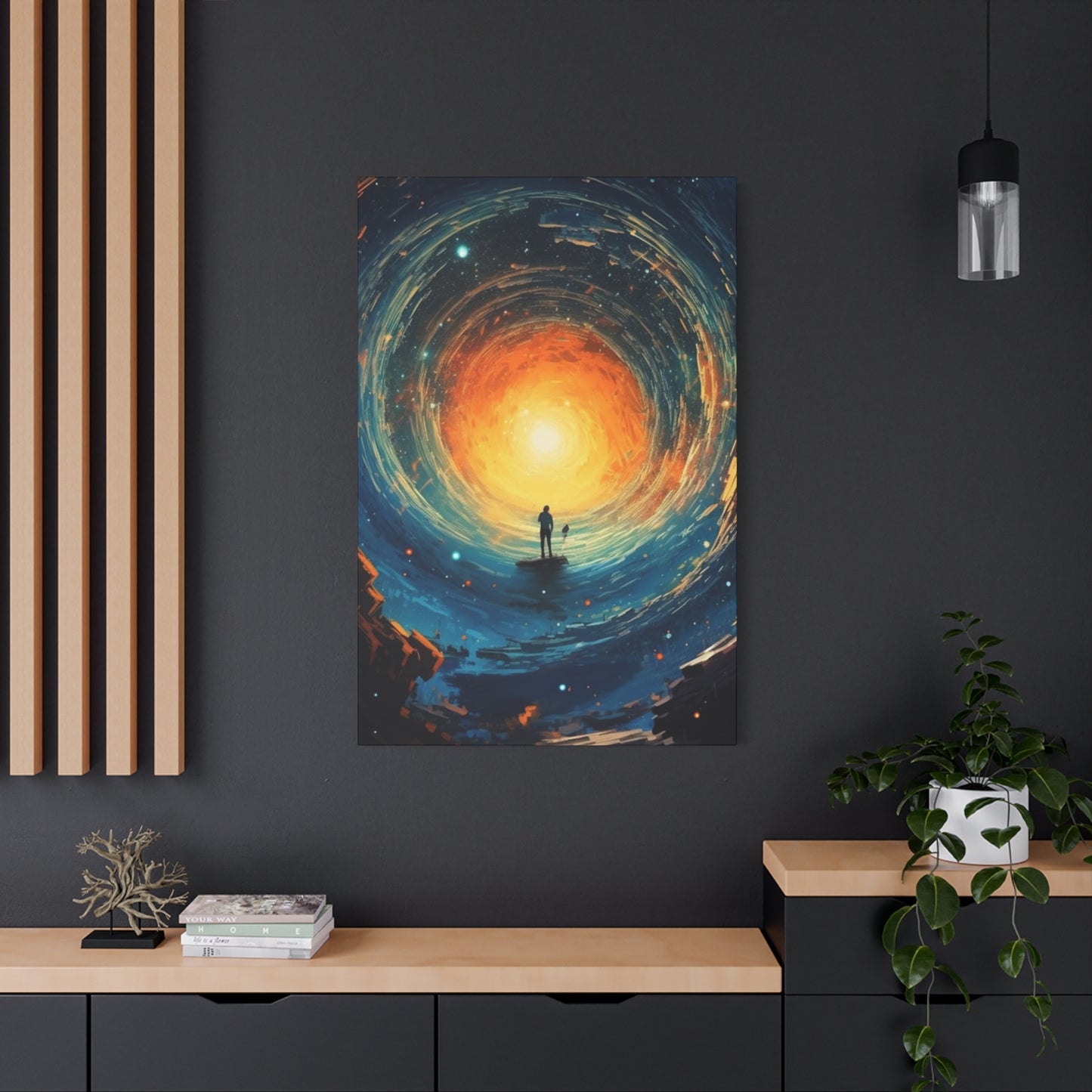A Journey of the Soul: Toward-God Light Wall Art for Spiritual Spaces
The human soul possesses an innate and profound yearning for connection, a deep-seated desire to reach for something beyond the tangible world. This quest for the divine, for meaning, and for a sense of sacred presence has been the driving force behind countless artistic endeavors throughout history. Art, in its purest form, becomes a vessel for this spiritual longing, a bridge between the seen and the unseen. Within this vast landscape of creative expression, a particularly resonant genre has emerged: wall art that captures the essence of divine light. These pieces, often rendered as stunning canvas prints, are more than mere decorations; they are windows into the numinous, portals that invite contemplation, and daily reminders of a higher purpose.
The concept of moving "toward God" is often metaphorically and literally expressed through the depiction of light. Light vanquishes darkness, it reveals what is hidden, it signifies purity, knowledge, and the very presence of the divine. Toward God Light Wall Art Canvas Prints encapsulate this powerful symbolism, transforming living spaces into sanctuaries of peace, inspiration, and spiritual reflection. This comprehensive exploration delves into the multifaceted world of this art form, examining its historical roots, diverse cultural interpretations, artistic techniques, psychological impact, and its role in creating a home environment that nurtures the soul. It is a journey into the heart of illumination, where every brushstroke, color choice, and composition is a step closer to the sacred.
The Canvas Print as a Modern Medium for Sacred Art
For centuries, sacred art was confined to specific, consecrated spaces—the frescoed walls of cathedrals, the gilded icons in monasteries, the intricate mosaics of mosques, and the sculpted deities in temples. These masterpieces were often inaccessible to the general populace for daily contemplation. The creation of this art was a painstaking, time-consuming, and expensive process, reserved for master artisans under the patronage of religious institutions or wealthy elites. While this created works of unparalleled beauty and historical significance, it also placed a physical and economic distance between the art and the individual believer. The advent of modern printing technology, particularly the development of high-quality canvas prints, has democratized the experience of sacred art, allowing these profound images to enter the most personal of spaces: our homes.
A canvas print offers a unique combination of qualities that make it an ideal medium for spiritual artwork. Unlike a simple paper poster, a canvas has texture. The woven fabric gives the artwork a tangible depth and a painterly quality that mimics an original piece of art. This texture interacts with light in a subtle way, enhancing the visual experience and making the artwork feel more substantial and permanent. It bridges the gap between a mass-produced item and a piece of fine art, lending a sense of authenticity and importance to the image it holds. Furthermore, the technology behind modern giclée canvas printing is truly remarkable. Using archival-quality inks and advanced printing techniques, it is possible to reproduce images with an astonishing range of colors, incredible detail, and subtle gradations of tone.
This is particularly crucial for art centered on the theme of divine light. The delicate transitions from a soft, ethereal glow to a brilliant, dazzling radiance can be captured with breathtaking fidelity. The deep, velvety blacks of a night sky and the brilliant, sun-drenched golds of a celestial dawn can coexist on the same canvas, creating the dramatic contrast that gives so many spiritual pieces their power. The durability of canvas prints also contributes to their suitability for this purpose. They are more resistant to fading and environmental damage than paper prints, ensuring that the inspirational image remains a vibrant part of the home for years to come. This longevity mirrors the timeless nature of the spiritual themes they depict.
The accessibility of canvas prints is perhaps their most revolutionary aspect. An individual can now choose from a virtually limitless gallery of spiritual images from around the world and across all traditions. They can select a piece that speaks directly to their personal faith, their spiritual path, or their aesthetic sensibilities. Whether it is a serene depiction of a landscape bathed in morning light, an abstract representation of cosmic energy, or a piece of intricate Islamic calligraphy art, this art can be brought into the living room, the bedroom, or a personal meditation space.
This act of choosing and displaying Toward God Light Wall Art Canvas Prints is a powerful statement of intent. It is a conscious decision to curate one's environment to reflect one's inner values. The home is no longer just a place of shelter; it becomes a sanctuary, a space intentionally designed to foster peace, encourage reflection, and serve as a constant, gentle reminder of one's connection to the divine. The canvas print acts as a focal point for prayer, meditation, or simple moments of quiet contemplation amidst the busyness of daily life. It is a modern altar, a personal window to the sacred, made possible by the fusion of timeless spiritual yearning and contemporary technology. This medium allows the sacred to become an intimate, daily companion on life's journey.
Depictions of Divine Light in Christian Wall Art
Christian art has a rich and storied history of using light to symbolize the presence of God, the divinity of Christ, and the workings of the Holy Spirit. From the glittering gold-leaf backgrounds of Byzantine icons to the dramatic chiaroscuro of the Baroque masters, light has been the primary visual tool for expressing the transcendent and the holy. Modern canvas prints drawing from this tradition continue to explore these themes, offering a wide array of styles that bring these sacred concepts into the contemporary home. A prominent theme in Christian wall art is the direct depiction of God's light from the heavens. This is often visualized as a powerful beam of light, or crepuscular rays, breaking through a dark and stormy sky.
This imagery is deeply symbolic, representing divine intervention, hope in times of despair, and God's grace piercing through the darkness of a fallen world. A canvas print featuring such a scene can be a source of immense comfort and encouragement, a visual reminder that even in the midst of life's trials, God's light is present and capable of breaking through. These pieces often feature majestic landscapes—mountains, seas, or forests—which serve to highlight the grandeur of God's creation, with the divine light acting as the central, animating force of the scene. The light is not just an atmospheric effect; it is the subject of the artwork itself, signifying revelation and divine communication.
Another significant area is the portrayal of Jesus as the "Light of the World." This can be depicted in various ways. Some artworks show Christ literally holding a lantern or emitting a radiant glow, illuminating a dark path, a direct visual reference to the scripture in the Gospel of John. Other, more subtle interpretations, focus on the light in his eyes or the serene, illuminated quality of his countenance. Abstract Christian art takes this concept even further. Instead of a figurative representation, the artist might use a burst of brilliant color—golds, whites, and soft yellows—emanating from a central point on the canvas, often incorporating the shape of a cross or a fish (Ichthys) symbol.
This non-representational approach allows for a more personal and contemplative experience, where the viewer can meditate on the essence of Christ's spiritual light without being tied to a specific physical depiction. These abstract pieces are particularly well-suited for modern interior design, blending seamlessly while providing a profound spiritual focal point. The Holy Spirit is also frequently represented through the symbolism of light. While often depicted as a dove, the Pentecost story describes "tongues of fire" descending upon the apostles. Artworks inspired by this event use vibrant, dynamic flashes of light and color to convey the energetic and transformative power of the Spirit. A canvas print that captures this fiery, divine energy can be incredibly uplifting, serving as a reminder of the potential for spiritual renewal and inspiration in one's own life.
The Radiance of the Sacred Word in Islamic Calligraphy Art
In Islamic art, the theological principle of aniconism—the avoidance of figurative images of sentient beings—led to the flourishing of other art forms to express the divine. Among these, Islamic calligraphy rose to become the most revered, considered the highest form of artistic expression. It is the art of rendering the sacred word of the Qur'an, the direct revelation from Allah, into a visually beautiful form. In this tradition, the calligraphy itself is not merely decorative text; it is a visual conduit to the divine, and the concept of light (Nur) is intricately woven into its very fabric and presentation. A central theme in Islamic theology is that the Qur'an itself is a form of light—a guide for humanity out of darkness. Therefore, when a calligrapher writes a verse, they are, in essence, giving physical form to that divine light.
The elegance of the scripts, whether the strong and angular Kufic or the fluid and cursive Thuluth, is designed to elevate the written word beyond mere communication to a state of spiritual resonance. On a canvas print, this art form takes on a new dimension. Modern artists often embed the calligraphy within designs that explicitly evoke the theme of light. This can be achieved through the use of radiant backgrounds, with soft gradients of color that seem to glow from behind the sacred text. Gold and silver inks or digital effects are frequently used, not just for their beauty, but because these metallic, reflective surfaces physically catch and play with the light in a room, making the artwork feel alive and dynamic. This shimmering quality is a visual metaphor for the illuminating nature of the words themselves.
Geometric patterns, another hallmark of Islamic art, are often used in conjunction with calligraphy. These intricate patterns, based on mathematical principles of harmony and order, represent the underlying unity and structure of the universe as created by Allah. When these patterns are used to frame or embellish calligraphy, they create a sense of infinite extension, as if the sacred words are emanating from the center of a celestial design. Many of these geometric designs are star-shaped or tessellated in a way that suggests a burst of light or a radiant star, further reinforcing the connection between the divine word and celestial illumination. The choice of verses for these artworks is also significant. Verses that speak directly of light, guidance, and the names of Allah—such as An-Nur (The Light) or Al-Hadi (The Guide)—are popular choices.
A canvas print featuring the Ayat an-Nur, for example, becomes a profound object of contemplation. The viewer not only reads the description of Allah as the "Light of the heavens and the earth" but also sees it represented visually through the radiant calligraphy and design. The artwork becomes a holistic experience, engaging both the intellect through the text and the soul through its luminous beauty. For the home, a piece of Islamic calligraphy art is more than just decor. It is a constant source of dhikr (remembrance of God). It transforms a wall into a statement of faith and a source of spiritual peace. Every glance at the flowing script and the glowing design serves as a gentle reminder of divine presence and guidance, filling the space with a sense of serenity and sacred purpose. The canvas becomes a focal point that radiates not just artistic beauty, but the spiritual light of the sacred word.
Capturing Celestial Wonder: Astronomy and Spiritual Art
The night sky has always been a source of awe and wonder for humanity. Long before the advent of modern science, ancient cultures looked to the stars, moon, and planets as divine entities, celestial signs, and maps of the cosmos. This innate connection between the heavens and the sacred continues to inspire artists today. The genre of celestial and astronomical wall art on canvas taps into this universal sense of wonder, blending scientific imagery with a profound spiritual sensibility. These pieces invite us to contemplate our place in the universe and connect with the immense, creative power that brought it all into being. Artworks depicting nebulae are particularly powerful examples of this fusion. Nebulae are vast interstellar clouds of dust and gas, often called "star nurseries" because they are the birthplaces of new stars.
The images captured by modern telescopes, like the Hubble, reveal these cosmic clouds in breathtaking detail, with swirling forms and vibrant colors that appear almost painterly. When rendered on a large canvas, a nebula becomes a stunning piece of abstract art. Yet, it is more than just a beautiful image; it is a visual representation of creation in progress. The glowing gases and brilliant points of newly formed stars evoke a sense of primordial, divine energy. For many, contemplating such an image is a spiritual experience, a moment of connection with the infinite and the creative force of the universe. It is a reminder of the immense beauty and mystery that exists beyond our earthly confines, fostering a sense of humility and wonder.
Galaxies are another popular subject. A canvas print showcasing the spiraling arms of the Andromeda galaxy or the majestic sweep of our own Milky Way can be deeply moving. The sheer scale is almost incomprehensible—billions of stars, each a potential sun, clustered together in a celestial dance. This perspective can shift our own perception of our problems and our lives, placing them within a much grander context. Spiritually, this can be interpreted as a visualization of the divine mind or the infinite nature of God. The swirling patterns can be seen as cosmic mandalas, focal points for meditation that draw the viewer's consciousness outward, away from the self and toward a sense of universal unity.
The use of light in these pieces is inherent. The light from distant stars and glowing nebulae travels for millions of years to reach us, making these images literally pictures of ancient light. This adds another layer of profundity to the artwork. It is a connection to the deep past and the vast expanse of time. Artists often enhance the natural colors and light in these astronomical images to heighten their emotional and spiritual impact, creating scenes that are both scientifically grounded and artistically transcendent. Even simpler celestial scenes, such as a luminous full moon against a dark sky or a meteor shower streaking across the canvas, can evoke a powerful spiritual response. The moon has long been a symbol of intuition, cycles, and the feminine divine. A meteor shower can represent fleeting moments of inspiration or divine messages.
The Role of Nature in Art Directed Toward God
Nature has perennially been viewed as the "second book" of divine revelation, a physical manifestation of the Creator's power, beauty, and wisdom. For millennia, seekers of spiritual truth have retreated to the wilderness to find clarity and connection. Art that channels this profound relationship between the natural world and the divine presence offers a powerful pathway to experiencing the sacred within the comfort of one's own home. Canvas prints that depict nature through the lens of spiritual light are not mere landscape paintings; they are invitations to see the world with sanctified eyes, to recognize the sublime in the seemingly ordinary, and to feel the presence of God in every leaf, sunbeam, and drop of water. One of the most common and effective motifs in this genre is the sunrise or sunset.
These moments of dramatic celestial transition are universally moving. A sunrise, with its soft pastel hues gradually giving way to brilliant gold, symbolizes new beginnings, hope, resurrection, and the triumph of light over darkness. A canvas capturing the first rays of dawn breaking over a mountain peak or a calm sea can infuse a room with a palpable sense of optimism and spiritual renewal. Conversely, a sunset, with its fiery oranges, deep reds, and rich purples, speaks of closure, gratitude, rest, and the beauty of surrender. It can serve as a reminder to release the worries of the day and to trust in the divine order. In both instances, the light is the primary actor in the scene, transforming the landscape into a cathedral of natural beauty.
Forests are another powerful setting for this type of art. A well-known image is that of sunbeams, or "God rays," slanting through a dense canopy of trees. This sight has an inherently reverent quality. The tall trees act as pillars of a natural temple, and the light that filters down feels like a direct blessing or a moment of divine grace. A canvas print depicting such a scene can bring a sense of tranquility and sanctuary into a home. It evokes the feeling of being in a sacred grove, a place of peace and quiet contemplation, away from the noise of the world. The interplay of light and shadow in these pieces is crucial, representing the spiritual journey's own moments of clarity and obscurity, all held within the larger, peaceful presence of the forest. Water, in all its forms, is also a rich symbol in spiritual art.
A calm, reflective lake mirroring a sunrise can symbolize inner peace, clarity of mind, and the soul's reflection of the divine. A powerful waterfall, with the sunlight creating rainbows in its mist, can represent the abundant and ceaseless flow of divine grace and life force. An expansive ocean scene, with light dancing on the waves, speaks to the infinite, powerful, and sometimes untamable nature of God, inspiring awe and humility. The key element in all these natural scenes is the artist's focus on the quality of the light. The light is not just illuminative; it is transformative. It is what elevates a simple landscape into a spiritual statement. It reveals the hidden colors in a leaf, makes the water sparkle with life, and turns the sky into a canvas for celestial drama.
Creating a Meditative Space with Spiritual Wall Art
In our increasingly fast-paced and distraction-filled world, the need for a personal sanctuary—a space dedicated to quiet, reflection, and spiritual connection—has never been more critical. Creating such a space within the home, whether it's an entire room or just a small corner, can have a profound impact on one's mental, emotional, and spiritual well-being. The visual elements within this space are of paramount importance, as they set the tone and serve as aids to focus the mind. Spiritual wall art, particularly canvas prints centered on the theme of divine light, can be the cornerstone of an effective meditative environment. The primary function of art in a meditation space is to help transition the mind from its ordinary state of busyness and anxiety to a state of calm and heightened awareness.
An image that is jarring, overly complex, or emotionally agitating would be counterproductive. Artworks depicting soft, diffused light are therefore ideal. Consider a canvas featuring an abstract composition with gentle gradients of color, moving from a soft violet to a pale blue, with a gentle, luminous white glow at the center. Such an image is soothing to the eye and does not demand intellectual analysis. It simply is. This allows the mind to relax and the practitioner to gently focus their attention. The soft light can be used as a visual anchor during meditation; instead of focusing solely on the breath, one can gently rest their gaze upon the artwork, allowing its peaceful energy to permeate their consciousness.
Art depicting serene natural landscapes bathed in gentle light is also exceptionally well-suited for this purpose. A canvas showing a misty morning over a calm lake, with the first light of dawn just beginning to touch the water, can evoke an immediate sense of peace. The mist symbolizes the quieting of the "monkey mind," and the emerging light represents the dawning of inner clarity and insight. Similarly, a minimalist piece featuring a single, soft beam of light against a simple, textured background can be incredibly powerful. This type of image encourages focus and represents the singular goal of many meditative practices: to find the unwavering light of consciousness within.
The choice of art is a deeply personal one and should resonate with the individual's own spiritual path. For some, a piece of intricate Islamic calligraphy art, with its flowing, prayerful lines, might create the ideal atmosphere for dhikr. For others, a Christian-themed artwork depicting a gentle, light-filled scene from the life of Jesus might foster a sense of devotional peace. For someone on a more secular spiritual path, an abstract representation of cosmic light or a celestial nebula might be the perfect catalyst for feelings of awe and interconnectedness. Beyond the image itself, the placement of the canvas print is key. It should be hung at eye level from where one typically sits to meditate.
It should be the primary focal point of the space, with the area around it kept clean and uncluttered. One might place a candle or a small plant beneath it to create a small altar-like setting. The lighting in the room should also complement the artwork, with soft, indirect lighting being preferable to harsh, overhead lights. By carefully selecting and placing a piece of Toward God Light Wall Art Canvas Prints, you are not just decorating a space; you are consecrating it. The artwork becomes more than an object on the wall; it transforms into a tool for spiritual practice, a portal to inner stillness, and a constant, silent guide leading the mind away from chaos and toward the serene light within.
The Psychology of Light and Color in Inspirational Decor
The impact of our physical environment on our psychological state is a well-documented phenomenon. Interior design is not just about aesthetics; it's about creating spaces that support our well-being. In the realm of inspirational decor, the strategic use of light and color is a primary tool for influencing mood, emotion, and even cognitive function. Spiritual wall art that is centered on the theme of divine light leverages these psychological principles to create an atmosphere that is not only beautiful but also emotionally and spiritually uplifting. Light itself is a powerful psychological trigger. Exposure to light, particularly bright light, is known to boost the production of serotonin, a neurotransmitter that plays a crucial role in mood regulation.
A lack of light, as experienced in seasonal affective disorder (SAD), can lead to feelings of depression and lethargy. Artworks that are filled with light—whether it's the brilliant light of a sunny day, the soft glow of a candle, or an abstract burst of radiance—can have a similar, albeit more subtle, effect. By simply having such an image in our field of vision, we can experience a gentle lift in our spirits. A canvas print depicting a sun-drenched landscape, for instance, can evoke feelings of warmth, energy, and optimism, making it an excellent choice for a living room or a home office where motivation and a positive outlook are desired.
The colors within the artwork are equally significant. Color psychology explores how different hues affect the human mind and body. The colors prevalent in spiritual light art are often those associated with positive psychological states. Yellow, the color of sunlight, is strongly associated with happiness, intellect, and energy. It stimulates mental activity and can generate feelings of joy. A piece of art with prominent yellow tones can make a space feel more cheerful and welcoming. White, the combination of all colors in the light spectrum, symbolizes purity, innocence, and new beginnings. It creates a sense of space, simplicity, and cleanliness. An abstract canvas with large areas of white can help to de-clutter the mind and promote a feeling of peace and clarity.
Gold is associated with wisdom, illumination, and wealth—both material and spiritual. Its metallic sheen adds a touch of luxury and importance, signifying the preciousness of the divine insight it represents. Blues, often used for skies and water, are calming colors. They are known to slow the heart rate and promote feelings of tranquility and serenity. A canvas with soft blues can be ideal for a bedroom or a meditation space, helping to create a restful atmosphere. Greens, the color of nature, symbolize growth, harmony, and renewal. Art featuring lush, light-filled landscapes can reduce stress and create a sense of balance. The artists creating Toward God Light Wall Art Canvas Prints often use these colors intuitively or intentionally to elicit a specific spiritual or emotional response.
A piece meant to be invigorating might use a dynamic interplay of bright yellows and whites. A piece designed for quiet contemplation might use a harmonious blend of soft blues, greens, and gentle lavender tones. By understanding the psychological impact of these visual elements, we can curate our home environment more effectively. Choosing a piece of art is not just a decorative decision; it's a wellness decision. We are selecting a visual influence that will be a part of our daily lives. By filling our walls with images of light, hope, and serenity, we are actively creating a home that supports not only our spiritual journey but our fundamental psychological health as well.
Artistic Techniques for Conveying Illumination on Canvas
Creating a convincing and moving depiction of light on a two-dimensional canvas is one of the greatest challenges and triumphs in art. It requires a mastery of various techniques that trick the eye into perceiving luminescence, depth, and atmosphere. When an artist aims to convey not just physical light but a sense of divine or sacred illumination, these techniques are imbued with an even greater significance. Understanding these methods can deepen our appreciation for the spiritual canvas prints we bring into our homes. One of the most fundamental techniques is the use of value, which refers to the lightness or darkness of a color. The dramatic use of high contrast between light and dark values is a technique known as chiaroscuro, famously mastered by Baroque painters like Caravaggio.
In a spiritual context, this technique is incredibly powerful. A canvas might feature a vast, dark, or shadowy background from which a single, brilliant light source emerges, illuminating a key figure or symbol. This intense contrast immediately draws the viewer's eye to the light, emphasizing its importance and power. It visually represents the idea of hope in darkness, revelation, or a divine presence piercing the veil of the mundane world. Even in less dramatic, more serene pieces, the careful management of value is key. A soft, ethereal glow is achieved through subtle and gradual shifts in value, with no harsh lines or abrupt changes, creating a feeling of gentle, all-encompassing peace.
Color temperature is another crucial tool. Light is not just white; it has color. The warm light of a sunrise is filled with yellows, oranges, and reds, which feel energizing, comforting, and passionate. The cool light of the moon or a twilight sky contains blues, indigos, and violets, which evoke feelings of calm, mystery, and introspection. An artist can use color temperature to set the entire emotional and spiritual tone of a piece. A canvas intended to inspire and uplift might be dominated by a warm palette, while one meant for quiet meditation would likely employ cooler tones. Often, the most dynamic pieces will use a combination of both, for example, a cool, blue-toned landscape being touched by the first warm, golden rays of dawn. This interplay creates visual excitement and can symbolize the meeting of the human (cool) and the divine (warm). Techniques for creating the illusion of radiance are also vital.
One method is the use of "halation," a soft, blurry edge around a light source that mimics the way our eyes perceive bright light. This makes the light seem to glow and bleed into its surroundings, giving it an active, energetic quality. In digital art and modern printing, a similar effect, often called a "glow" or "bloom," can be applied to make light sources appear intensely brilliant. Another technique involves layering and glazing. An artist might apply thin, transparent layers of paint (or achieve a similar effect digitally) to create a sense of depth and luminosity. Light appears to be coming from within the canvas itself, rather than just sitting on the surface. This is particularly effective for depicting the subtle, inner glow of a holy figure's halo or the deep, cosmic light of a nebula.
Finally, the composition itself can be used to direct the viewer's attention toward the light. Leading lines—such as the lines of a road, a river, or architectural elements—can be arranged to point directly to the light source. The "rule of thirds" might be used to place the brightest point of the canvas at a visually compelling intersection. These compositional choices are not accidental; they are a deliberate part of the artist's visual language, designed to guide the viewer's experience and emphasize the central theme of moving toward the divine light. When we look at a canvas print, we are seeing the culmination of these techniques, a skillful orchestration of value, color, and composition all working together to create a window into the luminous and the sacred.
Integrating Spiritual Art into Various Home Decor Styles
Spiritual wall art, with its profound themes and often stunning aesthetics, has the versatility to enhance a wide range of interior design styles. The key is to select pieces that complement the existing decor's ethos, color palette, and overall mood. Far from being confined to a specific "religious" or "new age" look, these artworks can be seamlessly integrated into modern, traditional, rustic, and minimalist homes, adding a layer of depth and personal meaning to the space. For a minimalist interior, which prioritizes simplicity, clean lines, and a neutral color palette, the right piece of spiritual art can serve as a powerful yet understated focal point. An abstract canvas featuring a simple, elegant composition would be an excellent choice.
Imagine a large canvas with a textured white or light gray background, with a single, graceful stroke of gold or silver calligraphy, or a minimalist geometric design that suggests a burst of light. This type of artwork respects the minimalist principle of "less is more" while introducing a touch of warmth and profound meaning. It doesn't shout for attention but invites quiet contemplation, perfectly aligning with the calm and uncluttered atmosphere of the design style. In a modern or contemporary home, which often features bold forms and a sophisticated palette, more dynamic and colorful pieces can be used. A large, abstract expressionist canvas with vibrant bursts of color representing cosmic energy or sacred illumination can act as a stunning centerpiece in a living room. A high-definition canvas print of a nebula or galaxy, with its deep blacks and vivid colors, would also complement a modern aesthetic, bridging the gap between science, art, and spirituality. The key is to choose unframed or gallery-wrapped canvases to maintain the clean, modern look.
For homes with a more traditional or classic decor, art that draws from historical styles can be a natural fit. A canvas print that emulates the style of the old masters, with rich colors and a dramatic use of light and shadow (chiaroscuro), can add a sense of timeless elegance. A beautiful depiction of a light-filled landscape or a symbolic still life with a lit candle could blend seamlessly with traditional furnishings. Reproductions of classic religious scenes, when printed on high-quality canvas, can bring a sense of history and reverence to a space. In this context, choosing a canvas with an ornate, gilded frame can further enhance the traditional feel. Rustic, farmhouse, or bohemian (boho) decor styles, which emphasize natural materials, textures, and a connection to the earth, are wonderfully complemented by spiritual art inspired by nature. A canvas print featuring sunbeams filtering through a forest, a misty mountain sunrise, or a serene lakeside scene would be perfectly at home.
These pieces reinforce the decor's organic and grounded feel while adding a spiritual dimension. The textured surface of the canvas itself pairs well with the wood, linen, and jute textures common in these styles. For a boho-chic interior, artworks with mandalas, celestial patterns, or symbols from various world traditions can be layered with other eclectic pieces to create a rich and personalized environment. No matter the decor style, the goal is to create a harmonious dialogue between the artwork and its surroundings. The canvas should not feel like an afterthought but an integral part of the room's story. By considering the style, color, and mood of the space, one can select a piece of Toward God Light Wall Art Canvas Prints that not only expresses personal faith or spirituality but also elevates the home's entire aesthetic, creating a space that is both beautiful and soul-nourishing.
The Symbolism of Dawn and Dusk in Spiritual Canvases
The daily cycle of the sun, with its glorious arrival at dawn and its gentle departure at dusk, provides two of the most symbolically rich and emotionally resonant moments for artists to capture. These transitional periods, known as the "golden hours" for their beautiful, warm light, are imbued with deep spiritual meaning across cultures. Canvas prints that focus on these specific times of day tap into a universal human experience, using the language of natural light to speak of profound spiritual truths like hope, renewal, gratitude, and surrender. Dawn is a powerful symbol of new beginnings. As the first light breaks through the darkness of night, it brings with it the promise of a new day, a fresh start, and a clean slate. This is a potent metaphor for spiritual rebirth and enlightenment.
A canvas depicting a sunrise, whether over mountains, an ocean, or a quiet field, can infuse a space with a sense of profound optimism. The colors of dawn—soft pinks, lavenders, and oranges, gradually building to a brilliant gold—are inherently gentle and hopeful. Displaying such an image in a bedroom can be a wonderful way to start the day, a visual reminder of the ever-present opportunity for renewal and growth. In a Christian context, dawn is powerfully associated with the resurrection of Christ, the ultimate victory of light over the darkness of death. An artwork of an empty tomb bathed in the light of a new day is a subtle yet powerful statement of faith. In a broader spiritual sense, the rising sun represents the awakening of consciousness, the dispelling of ignorance, and the journey out of personal darkness toward illumination.
Dusk, on the other hand, carries a different but equally profound set of spiritual connotations. As the sun sets, the light softens, and the world is painted in deep, rich hues of red, orange, and purple. This is a time for reflection, gratitude, and release. A canvas capturing a dramatic sunset can bring a sense of peace and closure to a room. It encourages the viewer to pause and appreciate the beauty of the day that has passed and to let go of its struggles and worries. The symbolism of the setting sun can be seen as a metaphor for surrendering one's personal will to a higher power, trusting that even as darkness falls, the light will return. It speaks of the cycles of life, the beauty in endings, and the necessity of rest and introspection. Displaying a sunset piece in a living room or a den can help create a calming atmosphere for the evening, a space to unwind and reconnect with oneself and with family.
The light at both dawn and dusk is unique. It is soft, diffused, and casts long shadows, which adds a sense of drama and depth to any scene. Artists are particularly drawn to these times because the low angle of the sun reveals textures and colors in the landscape that are invisible under the harsh light of midday. This special quality of light is what makes these artworks so captivating. It feels magical, transcendent, and inherently spiritual. Whether it's the quiet hope of the first light or the peaceful gratitude of the last, canvas prints depicting dawn and dusk are more than just pretty pictures. They are meditations on the sacred rhythms of life, constant reminders of the cycles of renewal and release that govern both the natural world and our own spiritual journeys toward God.
Choosing Art that Resonates with Your Personal Spiritual Path
The journey toward the divine is a deeply personal one. While spiritual traditions may offer established paths and communities, the individual's connection with the sacred is unique. When selecting spiritual wall art for the home, it is therefore essential to choose pieces that genuinely resonate with your own beliefs, experiences, and aspirations. The artwork should not be chosen based on trends or what one thinks "spiritual art" should look like, but on a gut-level connection. It should feel like it speaks your language, reflects your understanding of the divine, and supports the specific spiritual path you are walking. For an individual rooted in a specific faith tradition, such as Christianity, Islam, Judaism, or Buddhism, the choice might be more straightforward.
A Christian may feel a deep connection to a canvas depicting a scene from the life of Christ, a powerful image of a cross against a sunrise, or an abstract representation of the Holy Spirit's light. These images reinforce the core tenets of their faith and serve as daily reminders of their beliefs. Similarly, a Muslim will find profound peace and connection in a beautifully rendered piece of Islamic calligraphy art featuring a favorite verse from the Qur'an. The art becomes an extension of their devotional practice, transforming a part of their home into a space for prayer and remembrance.For those who identify as spiritual but not religious, or who draw inspiration from multiple traditions, the options are wonderfully broad. This path is often about finding the sacred in the universal—in nature, in the cosmos, in human connection, and within the self.
For such a person, a canvas print of a majestic, light-filled landscape might be the perfect representation of the divine, reflecting a belief in God as the creative force immanent in the natural world. A stunning image of a distant galaxy might resonate with a sense of cosmic consciousness and the interconnectedness of all things. Abstract art is particularly powerful for this spiritual path, as it allows for a purely personal interpretation. A canvas with a radiant burst of color could represent the inner light of the soul, the energy of the universe, or a moment of personal epiphany. The absence of specific iconography makes it a universal symbol of illumination that can be embraced by anyone, regardless of their specific creed. The process of choosing the art can itself be a spiritual practice.
It involves introspection and asking important questions: What brings me a sense of peace? What images make me feel hopeful and connected? What do I want to be reminded of each day? It may be helpful to browse a wide variety of styles and subjects, paying close attention to the emotional response each piece elicits. The right piece will often feel like a discovery, a sense of "yes, that's it." It will feel less like you are choosing the art and more like the art is choosing you. When a piece of Toward God Light Wall Art Canvas Prints is selected with this level of personal intention, it becomes far more than a decoration. It becomes a spiritual ally, a companion on your journey. It serves as a visual anchor for your intentions, a source of comfort in challenging times, and a joyful celebration of your unique connection to the light.
Conclusion:
The human journey, at its core, is a pilgrimage toward meaning, a deep and abiding quest for a connection to something greater than ourselves. Throughout this journey, we seek out markers, symbols, and reminders that can guide our steps and illuminate our path. We strive to create environments that not only shelter our bodies but also nourish our souls. The deliberate and thoughtful curation of our personal spaces is a powerful act of spiritual practice, a way of shaping our external world to reflect the inner world we wish to cultivate. In this sacred act of home-making, Toward God Light Wall Art Canvas Prints emerge as uniquely potent tools. They are far more than mere decorative objects; they are conduits of grace, windows to the transcendent, and silent companions on our spiritual journey. They harness the most universal and profound symbol—light—to speak of hope, creation, divinity, and the eternal victory of illumination over shadow.
This exploration has traversed the vast landscape of this art form, from the historical reverence for light across global spiritual traditions to the modern technological marvel of the giclée canvas print that brings these sacred images into our daily lives. We have seen how Christian art uses the language of light to tell stories of redemption and divine presence, and how Islamic calligraphy art transforms the sacred word itself into a radiant visual prayer. We have ventured into the cosmos, finding the hand of the Creator in the fiery birth of stars within distant nebulae, and dived deep into the human psyche, where abstract art uses color and form to express the ineffable feelings of spiritual awakening. We have walked through sun-dappled forests and stood on shores bathed in the hopeful glow of dawn, recognizing nature as a primary sanctuary and a reflection of divine beauty.
Furthermore, we have understood that the impact of this art is not confined to the esoteric or the purely aesthetic. It is grounded in the psychological power of light and color to elevate our mood and calm our minds. It is practical in its ability to transform a simple corner into a dedicated space for meditation and prayer. It is versatile, capable of elevating and deepening any interior design style, from the starkly minimalist to the richly traditional. And it is communal, serving as a focal point for family values and a gentle catalyst for meaningful conversations with all who enter our homes.
To choose to hang a piece of spiritual light art on your wall is to make a daily appointment with the sacred. It is an intentional act of punctuating the prose of ordinary life with the poetry of the divine. Each glance, whether fleeting or prolonged, becomes an opportunity for re-centering, for remembering, for gratitude. In a world fraught with distraction and noise, these canvases offer a moment of stillness, a focal point of peace. They are a gentle but persistent call to look up, to look inward, and to continue the soul's timeless journey toward the light. By bringing these emissaries of illumination into our homes, we do more than simply decorate a room; we consecrate a space, crafting a personal sanctuary where the soul can rest, recharge, and continue its beautiful and sacred ascent.


















